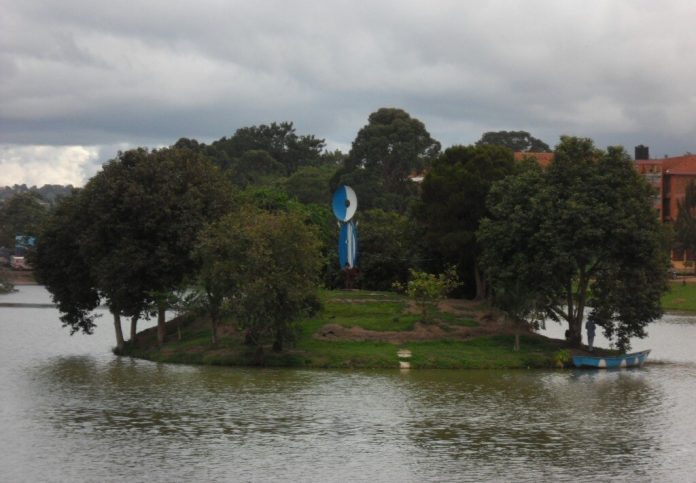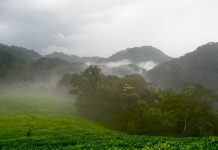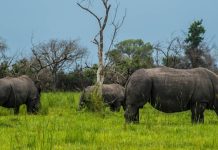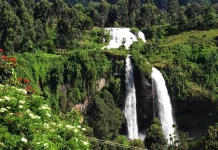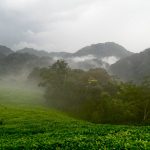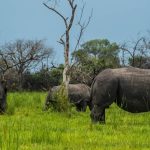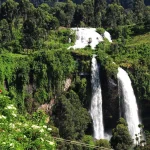The Buganda Kingdom has series of small sacred lakes and river that have not received much attention. These are regarded as places of divinity, danger and liminal makers. the Baganda take these lakes and rivers as their ancestral homes and go to there to make sacrifices to them. These places include; Kabaka’s lake, Lake Wamala, River Ssezibwa, Lake Victoria and among others
Kabaka’s lake

Kabaka’s Lake is located in Ndeeba between Nabunya road and ring road 4.5 km (13 min drive) from Kampala city, Uganda. Built in 1880 under the rule of Kabaka Mwanga II, this lake served as an escape route during British conflicts.
Being the largest man-made lake in Uganda, Kabaka’s Lake was a joint effort of 52 Buganda clans, showing unity during Ssekabaka Mwanga’s reign. Mwanga II had multiple reasons for its construction, including creating a waterway to Lake Victoria for fishing and swimming, as well as easy access to another palace on Mulungu hill.
Despite Kabaka Mwanga II’s aggressive rule, construction faced challenges due to religious wars in the Buganda Kingdom, leaving the lake incomplete. Initially, some royalty and chiefs refused to participate, but the Kabaka’s personal involvement changed their minds.
The lake covers 1.8 square kilometers and 200 feet deep, Kabaka’s Lake is a top attraction during a Kampala city tour. It harbors a variety of bird species like little egrets, crested cranes. The lake is near the Lubiri (Kabaka’s palace) in Mengo making it a must-visit.
With no inlet rivers, the lake relies on underground springs for water supply, maintaining consistent levels. Under renovation for tourism, future plans include a five-star hotel. During the annual Buganda tourism Expo in August, it features water sports with the king, soldiers (Abambowa), ministers, dignitaries, and security so as they funds solicited help in the renovation process.
Kabaka’s Lake is really special in Uganda, especially for the Buganda kingdom. People see it as a symbol of their history and culture. They use the lake for important ceremonies that are a big part of their traditions. The connection between the lake and the Buganda kingdom’s leaders makes it even more important culturally. The lake is a place that holds the stories and traditions of the Buganda people, making it a crucial part of their heritage.

Kabaka’s Lake is also recognized as a conservation area and a water reservoir for the kingdom and for irrigation and daily needs. boasts two small islands with lush vegetation and bird nests. The lake offers activities like canoeing, boat rides, leisure walks, picnics, birding and fishing.
Lake Wamala
Lake Wamala is a freshwater body shared by Mityana, Mpigi, and Mubende Districts covering 250 sq km with 1,290 meters above sea level. The lake has inlet rivers which include; Nyanzi, Kitenga, Kabasuma, Mpamujugu, and Bimbye rivers which contribute to the lake’s vitality.
Over 4,000 years ago, it is believed that lake Wamala was part of Lake Victoria, but time has shaped it into a separate waterbody we see now . The lake draws its name from King Wamala, the final ruler of the Bachwezi dynasty, who vanished into its depths near Nakyegalika, Lubajja landing site in Maanyi sub-county.

The lake’s surface is enhanced with islands, each telling its own story; these include Lwanja, Mabo, Kizara, Kazinga, and Bagwe Islands all harbor a variety of birdlife and serve cultural functions. Among the Baganda people, some islands are believed to house ancestral spirits, offering guidance and assistance.
Lake Wamala is surrounded by green vegetation that is dominated by papyrus, floaters, and water-based plants with a variety of tree species which include;Raphia, and palms thus creating a home for both flora and fauna.
The spot also has a variety of animal species and among them include; waterbucks, hippopotamus, sitatunga, wild pigs, bushbuck. And primates like vervet monkeys and baboons with birds like guinea fowl and turaco. The lake’s clear waters are also teeming with life, hosting fish species like tilapia, catfish, and lungfish.
In the 1960s and early 1970s, Lake Wamala played a crucial role as a source of fresh and smoked fish, supplying local markets and towns in Buganda. However, mismanagement and unregulated commercial fishing in the mid-1970s led to a decline in fish stocks. The impact was felt not only by the environment but also by local fishermen and their families.
Adding to the challenges, climate change is also another factor affecting the lake Wamala’s conditions and further impacting the livelihoods of the community. Yet, despite these challenges, Lake Wamala remains one of Uganda’s cleanest lakes, its waters maintaining a sense of calmness. Researched by Ariiho Robert Kahiigi, Lake Wamala was once a busy place and source of sustenance to people around. It now serves as a reminder to the delicate balance of nature and the importance of responsible stewardship to ensure the well-being of both the ecosystem and the communities that call its shores home.

There are other tourist attractions around for instance; Walumbe tanda pits, Entanda cultural center, Magonga shrines and Nakayima tree. These are all cultural attractions that are stationed around Mityana.
Lake Wamala with Buganda culture
In 2013, according to a story that was shared with social scientist Beth Timmers by a local fishmonger following the story that was passed down by grandparents. It is said the lake was born from a woman named Wamala, who, while pregnant, had her water break as she walked. The water flowed, and the lake grew, giving birth to Wamala, the lake itself. It is still believed to be the lake of a spirit which is beyond the government’s control.
This mysticism extends to certain taboos associated with the lake. The water is considered akin to Wamala’s mother’s amniotic fluid, making it taboo for menstruating women to enter the lake. Engaging in any activity, even bathing, is deemed disrespectful. These taboos are closely tied to the belief in women’s potential to fish.
Another prohibition revolves around the lake’s gender; as a male entity, it’s considered inappropriate for a woman to enter or exit a fishing boat. The cultural tapestry surrounding Lake Wamala is woven with stories that go beyond the ordinary, reminding us of the deep connection between myth, tradition, and the serene waters that cradle the spirit of Wamala.
How to get to lake Wamala
From Kampala city one can take Kampala-Fort Portal road up to Mityana town, then from town to the lake Wamala takes 20 km. From Kibale national park it is about 231 km (4 hrs and 30 mins) to reach the destination.
River sezibwa

Located 85 km (2 hrs and 30 mins drive) away from Kampala city center along the main road to jinja in Mukono district. River Sezibwa is one of the most treasured rivers in Buganda Kingdom and it originates from the wetlands of lake Victoria and pours its waters in lake Kyoga. The river is 150 km long and incorporates Ssezibwa falls. The falls are one of the most visited places and adorned with rocks, the water squeezes through narrow rock openings, cascading 17 meters into a 14-meter deep pool.
Cultural and Spiritual Significance of the river
Beyond its natural allure, Ssezibwa Falls holds profound cultural and spiritual significance, particularly for the Baganda people. The name “Ssezibwa” itself is a local idiom, meaning “something endless.”
The tourism place is administered by the Buganda culture and tourism department since it is an essential part of Buganda’s history and beliefs. According to local legend, the falls are linked to the supernatural powers of the river Ssezibwa.
Legends of Birth and Flow of River Sezibwa
Acord to the folktales from the locals, a woman named Nakangu Tebatuusa left her marital home due to issues with her husband, Nsubuga Sebwaata. She was directed by her father to reconcile with the husband; the mother accompanied her and on the way she gave birth to twins in the form of water near her home. One river, named Bwanda, flowed towards the East to Nyenga, while the other, Sezibwa, flowed westward, encountering various obstacles.
Sezibwa faced challenges along its course, but was aided by a spirit named Nnalongo Nnkubo. This benevolent spirit settled in the area around the waterfalls, leading to the construction of shrines for worship. The birth of these rivers and the mystical presence of spirits have intertwined the falls with cultural practices and beliefs, making it a revered site for the Baganda people.

Biodiversity and Wildlife
The area surrounding Ssezibwa Falls teems with biodiversity as it is a home to small primates like Vervet and red-tailed monkeys that play amidst the rocks. Snakes, including the African cobra, green mambas, and horned adders, find their habitat here, showcasing the delicate balance between nature and wildlife. Other inhabitants of the area include otters, tadpoles, mongooses, and wild cats, creating a diverse ecosystem that enhances the allure of Ssezibwa Falls.
Historical Plantings by Kings
Throughout history, Ssezibwa Falls has witnessed the reverence of Buganda kings who recognized its spiritual importance. In 1889, Kabaka Mwanga, charmed by the natural beauty of the falls, planted a wild olive tree, now known as the Mwanga tree. Over a century old, this tree stands as a living testament to the enduring connection between royalty and the falls.
Later, King Muteesa II also paid homage by planting a tree, acknowledging the spiritual significance of Ssezibwa Falls. In 2002, King Ronald Mwenda Mutebi II further solidified the falls’ importance by commissioning it as one of Buganda’s essential tourism sites, ensuring its preservation and recognition.
Spiritual Practices and Rituals at River Sezibwa
Ssezibwa Falls continues to be a site of spiritual significance for both locals and visitors. People from all over Uganda make pilgrimages to seek blessings for various aspects of their lives, including health, jobs, children, business, and families. Traditional healers, known as medicine men, invoke the gods or use local herbs to cure ailments ranging from diseases to toothaches and skin conditions.

The falls become a sacred space for rituals, where sacrifices are offered to win the favor of the gods. Offerings may include coffee beans, eggs, local beer, chickens, or even animals like sheep and goats. These rituals, rooted in ancient beliefs, are performed on top of the falls, and the offerings are dropped into the water to appease the gods and feed Ssezibwa.
Twins hold a special place in Buganda culture due to the legend of Ssezibwa Falls. Their birth is considered a blessing, and rituals are performed to appease the gods. Parents of twins receive special names such as Salongo (Father) or Nalongo (Mother), highlighting the cultural significance attributed to this unique phenomenon.
Blend of Traditions and religion
Despite the deep-rooted cultural practices, Ssezibwa Falls is not confined to one religious or cultural perspective. The Anglican church owns land close to the falls, where Christians come for retreats and meditation. The waters of Ssezibwa Falls also serve as a setting for baptism services, symbolizing the harmonious coexistence of traditional beliefs and Christian practices.
This unique blend of traditions further enriches the culture of Ssezibwa Falls, making it a destination where different features of Ugandan heritage converge. The falls, with their captivating history and diverse offerings, continue to be a place of contemplation, celebration, and connection with both the natural and spiritual realms.
How to get to Sezibwa river and falls
Once you set out from Kampala, one can use Kampala-jinja highway and turn right at Kayanja trading center onto a dirt road and it is 1.5km to the falls.however, the road transforms into murram as you approach the falls, making it essential to have a reliable 4 Wheel Drive Car, especially during the rainy season. As you’re traveling it’s advisable to drive cautiously, keeping a keen eye out for the main junction directing you to the falls. Despite a signpost indicating the direction to the Ssezibwa River Resort, it’s easy to miss, so stay alert.
Upon passing through the main gate, crafted from reeds, you’re greeted by the soothing sounds of the waterfalls. The area is adorned with trees thus harboring wildlife species like birds . As you venture further into the facility, the waterfalls come into view, accompanied by a bridge that spans the river downstream. This bridge not only offers the best point to admire the falls but also provides an excellent spot for capturing memorable photos. Further after crossing the bridge, the landscape is adorned with rocks and more trees making it a good environment for relaxation. The entrance fee is UGX 10000 and the place is open throughout the year. In case one wants to experience the force of falls, it is advisable to visit during rainy seasons.
Activities to do at Sezibwa

Whether you’re arriving from a thrilling whitewater rafting experience in Jinja or exploring Mount Elgon in Eastern Districts of Uganda, Ssezibwa Falls offers a variety of engaging activities which include; swimming, picnics, rock hikings, and among others. Further it emerges as a hidden oasis for relaxation and adventure. Being in close proximity to Kampala, this destination stands out for its affordability, making it an ideal spot for a weekend retreat or a holiday break.
Swimming
While the facility encourages caution, experienced swimmers can take a refreshing plunge into the pool below the falls. The clear and clean waters offer a tempting opportunity for a natural dip, making it a rewarding experience for those seeking a closer connection with nature.
Hiking and Climbing Rocks
This involves hiking atop the falls to view the River Ssezibwa cascading down the rocks from the thickets and trees. While the hike may pose a challenge for those less fit, the breathtaking views of the waterfalls and surrounding scenery make it a rewarding endeavor. On the way you may spot lizards and other creatures along the way.
Birdwatching
Tourists are involved in birdwatching amidst the forest surrounding Ssezibwa Falls. It is a home to over 50 bird species, the area becomes a sanctuary for birders. Spot African Finfoot and the Long-tailed Cormorant enjoying a swim at the foot of the falls, alongside other species like the African Grey Hornbill and Shining Blue Kingfisher.
Nature Walks
These are done in the surrounding forests, which feature bamboo, Muvule, Musizi, Mahogany, fig, Eucalyptus, and Ebony trees. It also has thickets and lushes. These nature walks are Guided by local experts as you are able to explore the diverse flora and fauna, spotting birds, butterflies, and small primates. Within these forests there are local farms and plantations and visitors are allowed to walk through however the international tourists are charged $4. This money pays the guide and also helps in the conservation of the forests.
Village Walks
Experience the warmth of local hospitality with village walks through Ngogwe, Madudu, Wamala, and Kungu. Intentional tourists tend to have close counters with locals and local students tend to conduct fieldwork and research within this area. They find these walks an excellent opportunity to connect with African home life. The experience may include a nominal fee of 10,000 Uganda shillings per person.
Cultural Experience

Before the arrival and spread of christianity and other religions, Buganda had ancient cultural practices where they built many shrines that belonged to different deities which included Jajja Ssezibwa shrine. The Buganda pay a visit to Jajja Ssezibwa’s Shrine which is located next to the waterfalls so as to gain insights into traditional religions, ancient gods, and spiritual beings. The shrine has several objects for spiritual use for instance, calabashes, coffee beans, pots, cowrie shells, backcloths, beans, spears, pangas and among others. Smoke is witnessed rising from the falls during sacrifices made to water and other deities. Note that entry into the shrine is restricted, as women are not allowed to go inside the shrine which is built inside the cave. In addition men who have not engaged in sexual intercourse the day before are the only ones allowed to enter and certain cultural practices may be unfamiliar to those of different denominations.
Picnics and Camping
The presence of lush green gardens around Ssezibwa Falls provide an ideal setting for picnics, small family gatherings, and merry-making. Set up a picnic spot under tall trees, enjoying the cool breeze and the mesmerizing waterfalls. Those interested in camping can find nearly flat grounds after the bridge, offering a good environment with the sounds of birds and primates. It is advisable to bring your own supplies for a camping experience including eats and drinks..
